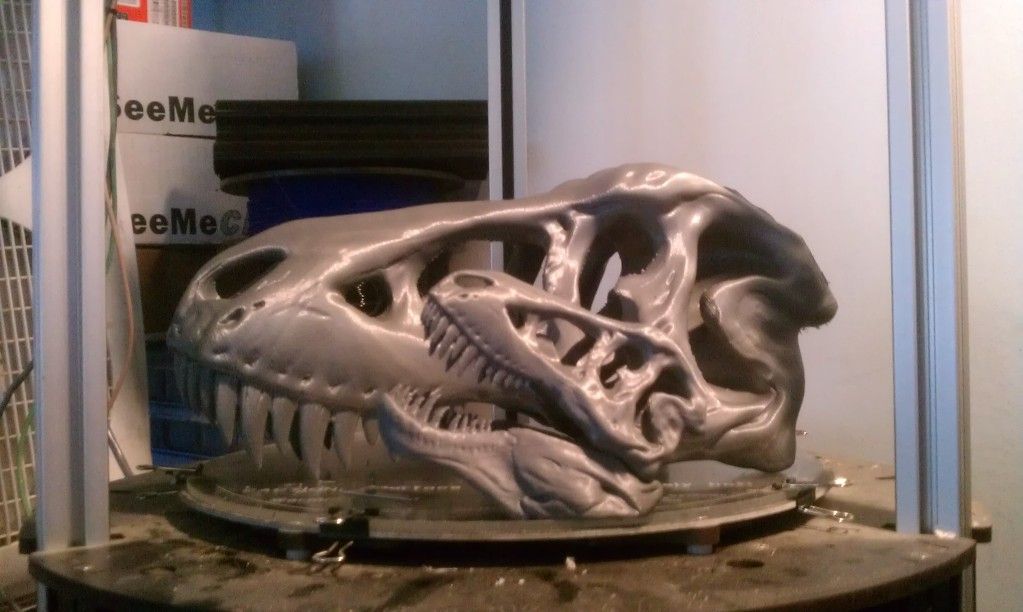
Jerry
SuperDork
8/26/14 8:09 a.m.
I stopped at Microcenter Mall on the way home yesterday to replace my ancient IBM optical mouse that even with speed maxed out I have to pick up and move over again to go across my screen.
Killing time before our Quaker Steak meet I wandered around and saw not one, not even two, but 4-5 different 3D printers! $$ range from $2500 down to about $499. Now my inner geek took over. Car parts and Star Wars toys.
How useful are these? Are they easy to program what you really want to build, or do you need templates or something? Please learn me, $500 is in my budget for a "useful" toy. I use useful term sparingly.
Not "useful".
I've had a high-end consumer one. I've also worked with several professional models.
This is similar to my experience: http://arstechnica.com/gadgets/2013/08/home-3d-printers-take-us-on-a-maddening-journey-into-another-dimension/
Can a 3D printer print a 2D printer?
A 3D printer can't print a 2D printer...it needs metal shafts, motors, belts, circuit boards, all kinds of stuff 
They can be useful for making little odds and ends, part prototypes, or even some working finished parts, but it's not that easy, you need to be good with CAD to design your own parts.
I heard at Carnegie Mellon you can use their 3d printer for free :)

Jerry
SuperDork
8/26/14 2:37 p.m.
ProDarwin wrote:
Not "useful".
I've had a high-end consumer one. I've also worked with several professional models.
This is similar to my experience: http://arstechnica.com/gadgets/2013/08/home-3d-printers-take-us-on-a-maddening-journey-into-another-dimension/
This sounds completely like what I expected. I'll let the others be the early adopter's, and maybe another 5 years. Like everything else.
I wondered if they'd be useful to create customized bushings or whatnot.
ProDarwin wrote:
Not "useful".
I've had a high-end consumer one. I've also worked with several professional models.
This is similar to my experience: http://arstechnica.com/gadgets/2013/08/home-3d-printers-take-us-on-a-maddening-journey-into-another-dimension/
I have only used the 5 and 6 figure industrial ones for printing things for work and we have had astonishingly good result. 2200$ for a basic maker-bot pays for a lot of time and plastic at a print house currently and lets you do the work you really need to do and not fiddle around with things.
The low cost ABS line layer types are more or less only good for making mockups, molds, things of that nature, the parts they make are not very strong.
I have 3 extruder types and have to say they can be awesome for many things, but complete wastes of time for others. For many one-off low impact parts they are amazing. If you want to print parts for high wear, high stress applications you will be disappointed.

Jerry
SuperDork
8/26/14 8:10 p.m.
I admit I was thinking more R2D2 sculptures and maybe a shift handle with my initials or a scorpion. 

Kenny_McCormic wrote:
The low cost ABS line layer types are more or less only good for making mockups, molds, things of that nature, the parts they make are not very strong.
Not entirely true. While a 3d printed part may not be of equal strength to an injection-molded part of equal dimensions, if you do a lot of 3d printing you quickly learn to design things to maximize the strength in critical areas within the limitations of the printer.
I've got a couple Solidoodle printers and they can be frustrating, but for low-volume manufacturing of simple parts they're amazing. I print a lot of parts I use in the camera dolly business that I simply couldn't afford to do via injection molding or individual fabrication. Injection molding is wicked cheap, but the molds are not, and once made, they provide no room to adjust the design.
The biggest downside of 3d printings that it is still very much an emerging technology. It's a bit of an unwritten rule that end users of the products (even the pricier ones that advertise "plug and play" functionality) are still participants in the development process. I haven't seen a true "plug and play" printer out there for the home market yet.
The flip side is that the technology is relatively simple, and if you can work on a car you can almost certainly work on a 3d printer. Some of the members of the online community are the worst kind of heinous, antisocial nerds, but you probably get that in any braniac-based online community. a lot of them sure are good at typing "do a search, noob" though.
We recently got a Stratasys Mojo where I work. It is $10k machine and basically the beginning of the commercial machines. It has been good for making fixtures and stuff. We had some problems with our initial batch of material.
I have been thinking of getting a Simplebot after reading good reviews of it in Make Magazine even if it is just to mess around with. It is only $400.

NOHOME
SuperDork
8/27/14 6:22 a.m.
$800 Soliddoodle at work has saved us many thousands of dollars that we used to spend at the machine shop making simple fixtures and jigs.
We feed it from Solidworks, but I hear Google Sketch-up will also work and its free. Solidworks sure as E36 M3 aint!
This technology is going to go huge as it combines with cheap scanners to eliminate the drawing bit. As with all things Star Trek...they seem to come true; is this the start of the replicator? I am waiting for the first edible 3D printed item!

JThw8
PowerDork
8/27/14 6:37 a.m.
NOHOME wrote:
I am waiting for the first edible 3D printed item!
http://money.cnn.com/2011/01/24/technology/3D_food_printer/
Fun fact: The only way a replicator could work IRL, is by working like a 3D printer - but maybe using nanobots instead of a single print head. If it turned energy into matter as in Star Trek, it would require ridiculous and unusable amounts of energy, even by Star Trek standards.

I do some hobby level metal casting, and there are a lot of guys on our forum using PLA printed parts as investment pieces for highly intricate metal castings. One guy recently printed a scale T-rex skull, with all the intricate nooks and crannies, hollow spots, undercuts, and dead space a real skull would have.

The plan is to invest the PLA skull in a type of high temp plaster used by metal sculptors, burn out the PLA, leaving a void in the plaster where the printed skull was, and then fill the void with liquid brass. I know he mentioned he has about $1k into his rig, and has had SUPER repeatable results, just as good looking as that above. Ive asked for some more details regarding his setup, how close/far it is from stock, and if he has a build thread anywhere for it...if I get any better details, I will surely post them.
Basically though, the same process as mentioned above can be done with cast iron, aluminum and bronze...Custom cast iron turbo manifolds? Super light and super stiff custom control arms? Custom length/profile intake runners or plenums? All of these are possible if you can draw up the part in CAD/Solidworks/whatever. I have a LOT of ideas for this...

NOHOME
SuperDork
8/27/14 12:48 p.m.
GameboyRMH wrote:
Fun fact: The only way a replicator could work IRL, is by working like a 3D printer - but maybe using nanobots instead of a single print head. If it turned energy into matter as in Star Trek, it would require ridiculous and unusable amounts of energy, even by Star Trek standards.
OK, now that I have my cake, what I want is a machine where I pour hydrogen into the hopper and get whatever the hell I want out the other end. And yeah...I want it to be big enough to do cars!




































